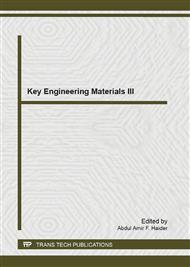p.364
p.370
p.375
p.378
p.382
p.389
p.394
p.399
p.403
Experimental Study on Welding Fumes Exposure from Aluminum Metal Inert Gas (MIG) Process
Abstract:
Welding fumes are known as hazard that can cause acute health effects. Welders exposures to welding fumes are oftentimes difficult to evaluate due to the different parameters settings exist in their workplace. Therefore, this experimental study focused on welding fumes exposure towards aluminum metal inert gas (MIG) welders. The experimental set-up was done by using a dummy welder and a welding machine attached to Computer Numerical Control (CNC) workbench for programmable welding route. This preliminary experiment aims at comparing results between scanning electron microscope with energy dispersive spectroscopy (SEM-EDS), inductively coupled mass spectroscopy (ICP-MS) and atomic absorption spectrometry (AAS) analysis method. New insight on the consistency of the SEM-EDS experimental results, comparison of element detected by using SEM-EDS and ICP-MS result analysis and the different elements detected between standing and sitting welding position were recognized through this preliminary experimental study. It is concluded that SEM-EDS analysis are not suitable to be used as a preliminary analysis to shortlist the metal elements exists in the welding fumes sample due to the misleading results if compared to the elemental characterization measure proportional to the atomic number such as ICP-MS.
Info:
Periodical:
Pages:
382-386
Citation:
Online since:
May 2013
Keywords:
Price:
Сopyright:
© 2013 Trans Tech Publications Ltd. All Rights Reserved
Share:
Citation:


